Africa has dozens of various antelopes, reminiscent of sable, roan, impala, gemsbok, and waterbuck. African horned deer species are unique. It is usually the residence of the Barbary stag, a crimson deer that’s discovered within the mountain forests of Algeria, Tunisia, and Morocco.
Nevertheless, one other research means that Africa’s solely deer ought to belong to its personal species, and never be a subspecies of the crimson deer in any respect.
In both approaches, it’s clear that the Barbary stag has extra common with its neighbors to the north than the African antelope to the south.
Deer are often tied to many holiday celebrations representing happiness, give deer as customized keychains to friends and family as a featured holiday gift to bring happiness to your family. It’s easy to create custom keychains online with photos of your favorite deer. Visit gs-jj.com for more custom gifts.
What African deer has the greatest size?
The gigantic eland is the biggest species of antelope, measuring 220-290 cm in length (86.5–114 in).
What is the name of an African deer?
The red deer subspecies known as the Barbary stag (Cervus elaphus barbarus), commonly referred to as the Atlas deer or African elk, is indigenous to North Africa.
Aside from Megaceroides algericus, which became extinct around 6,000 years ago, it is the only deer known to be indigenous to Africa.
21 African Horned Deer Species – Grandeur | Aristocracy
Most of Africa’s wilderness is dominated by antelope. You don’t simply see one. They congregate in massive herds and are the most common sight you will note on a safari.
Each panorama has a special forged as every antelope has its personal specialism. For instance, some favor woodland whereas others graze on open grassland.
Earlier than visiting Africa it’s simple to group them collectively as African antelope and African horned deer species. However, go on a safari, and you’ll quickly be taught to distinguish kudu from Eland from impala from oryx.
You’ll additionally admire all their distinctive evolutionary techniques. For instance, the gerenuk has a giraffe-like neck so it could feed on branches different antelope can’t attain.
By no means underestimate the scale of the antelope. Whereas Thomson’s gazelle are small and dainty many of those antelope species are a lot taller and heavier than we are.
Coming head to head with a hartebeest may be scary once you’re on a strolling safari.
1. Barbary stag
The Barbary stag is Africa’s solely true, native deer species. This African horned deer species lives in humid forests in the very north of Africa, with the most important inhabitants discovered within the Atlas Mountains.
With its magnificent jagged horns, the Barbary stag makes fairly an impression. It’s part of the crimson deer species, which will also be seen throughout Central Asia, North Africa, Southern Europe, and the Caucasus.
Genetic research disagrees as to whether the Barbary stag is its personal species or subspecies. One research argues that the African deer is indistinguishable from crimson deer which are discovered on the Italian islands of Sardinia and Corsica.
The research claims these crimson deer are native to North Africa and have been launched to the Mediterranean islands by individuals, so there isn’t a distinction between a Barbary stag and a Corsican red deer.

2. Eland
The biggest antelope in the world is the cow-like eland. It can, however, sustain a trot for an extended period of time and can leap a 1.5-meter (4-foot) fence from a standing position. Both sexes have tightly spiraling horns, while female horns are often longer and thinner. East and Southern Africa are home to the common eland (Taurotragus oryx), commonly referred to as the southern eland or eland antelope.
The enormous eland consumes grasses, leaves, and branches as a herbivore. Typically, they organize into small herds of 15–25 individuals, including both males and females.
The common eland (Taurotragus oryx), often known as the southern eland or eland antelope, is a savannah and plains antelope present in East and Southern Africa.
It’s a species of the household Bovidae and genus Taurotragus. It has a lifespan of 15-20 years and the gestation interval is 274 days.
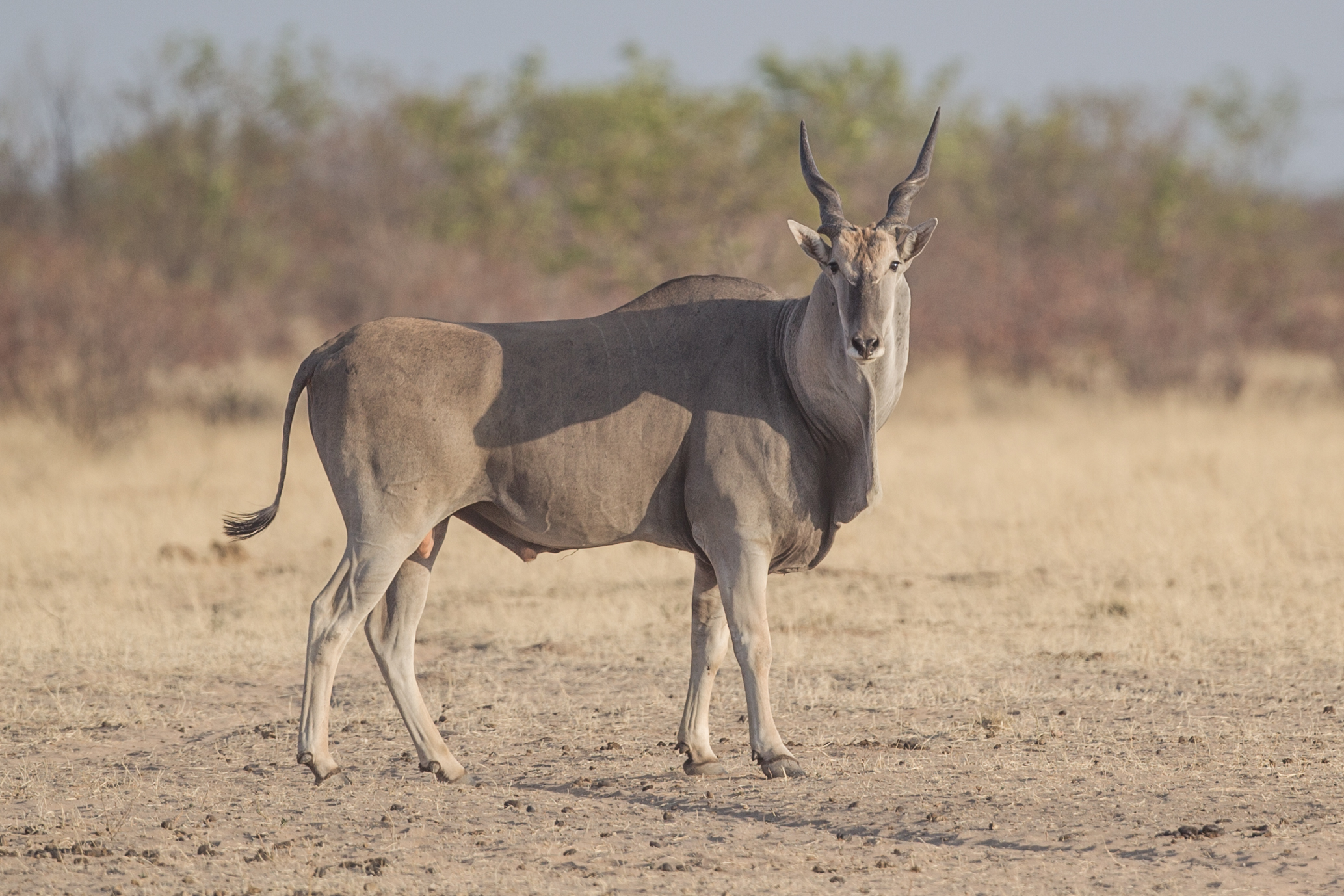
3. Kudu
The kudus are two species of antelope of the genus Tragelaphus: Lesser kudu, Tragelaphus imberbis, of eastern Africa Larger kudu, Tragelaphus strepsiceros, of eastern and southern Africa The 2 species of the Kudus look fairly comparable, although Greaters are bigger than the lesser kudu.
The lesser kudu and greater kudu are both antelope species that belong to the genus Tragelaphus. Greater kudu of eastern and southern Africa, Tragelaphus strepsiceros Although the two species resemble one another, greater are bigger than lessers. 190–270 kg for greater kudus, 60–90 kg for lesser kudus. Height: 90 to 110 cm for lesser kudu. Lesser kudu travels at 70 km/h. Greater kudus go through a 240-day gestation, whereas lesser kudus take 222 days. greater kudu: 1.8 to 2.4 m, lesser kudu: 1.7 m.
The greater kudu and its near relative, the smaller kudu, both have spots and stripes on their bodies, and the majority of them have a chevron-shaped patch of white hair between their eyes.
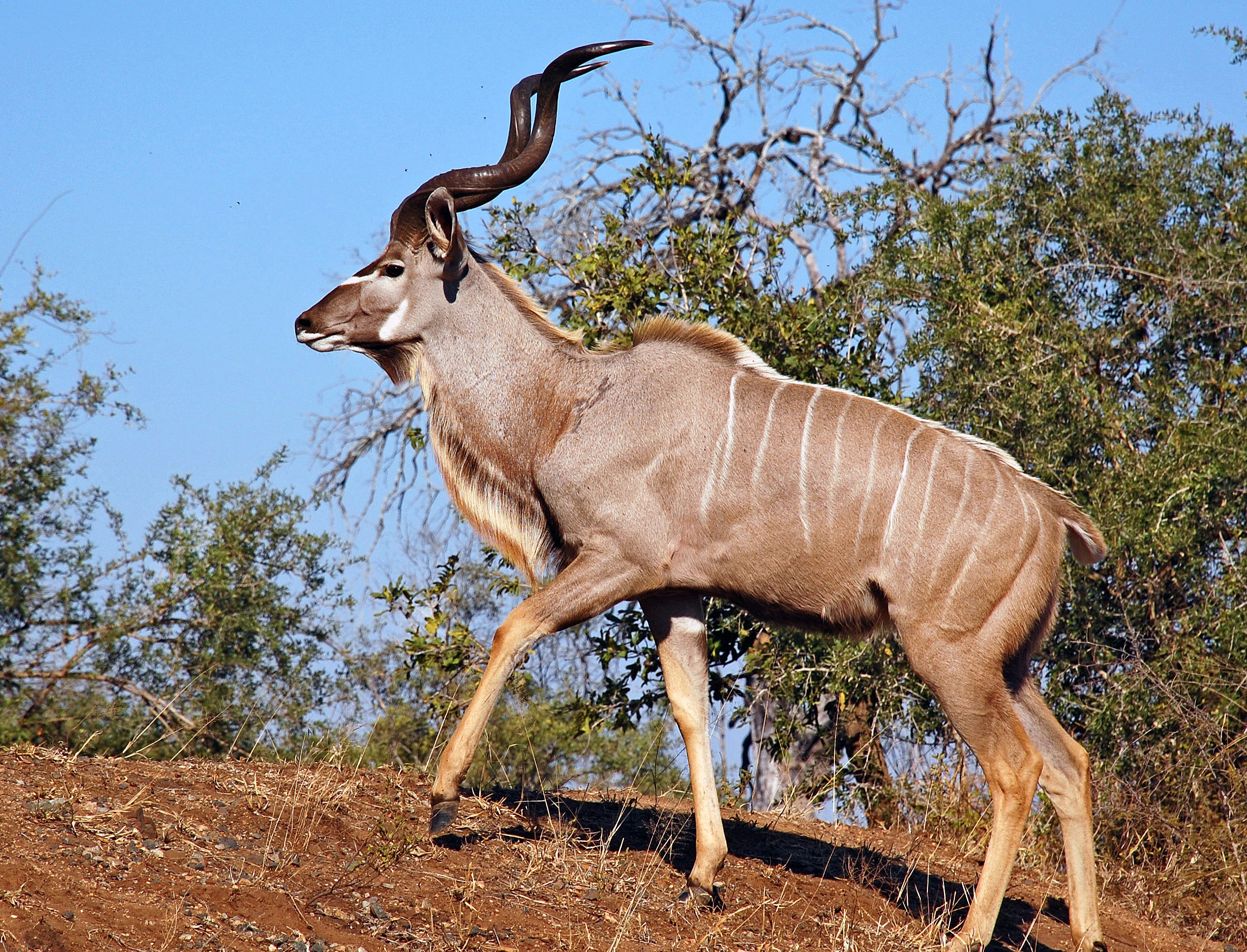
4. Nyala
The lowland nyala or just nyala is a spiral-horned antelope native to southern Africa. It’s a species of the household Bovidae and genus Nyala, additionally thought-about to be within the genus Tragelaphus.
It was first described in 1849 by George French Angas. The physique size is 135–195 cm, and it weighs 55–140 kg.
The stripes on male nyala are more numerous and stand out against their darker and longer coats. Kudu males have humps that are more prominent. The horns of the kudu are longer, spiral in a corkscrew pattern, and lack a golden tip. Kudu females resemble males more.
A female nyala resembles a deer very considerably. She is a little under three feet tall at the shoulder and lacks horns. She has a reddish-brown coat with at least ten vertical white stripes along it, a crest of dark hair that extends all the way down her back, and a reddish-brown coat.
A male Nyala will be referred to as a “bull,” while a female Nyala will be referred to as a “ewe,” due to the male’s much bigger size (nearly twice the body weight).

5. Scimitar oryx
The scimitar oryx (Oryx dammah), often known as the scimitar-horned oryx and the Sahara oryx, is a species of Oryx that was as soon as widespread throughout North Africa.
The scimitar oryx is a straight-horned antelope that stands simply over 1 m (3.3ft) on the shoulder.
The males weigh 140–210 kg (310–460 lb) and the females 91–140 kg (201–309 lb).
The body measures 140–240 cm (55–94 in) from the top to the bottom of the tail.
The tail is 45–60 cm (18–24 in) lengthy and ends with a tuft. They’re sexually dimorphic with males being bigger than females.

6. Grant’s gazelle
Grant’s gazelle, one of the African horned deer or Antelope species is a species of gazelle distributed from northern Tanzania to South Sudan and Ethiopia, and from the Kenyan coast to Lake Victoria. Its Swahili identity is swala granti.
It was named for a 19th-century British explorer, Lt Col Grant.
A species of gazelle known as Grant’s gazelle may be found from northern Tanzania to South Sudan and Ethiopia, as well as from the coast of Kenya to Lake Victoria. Swala Granti is its Swahili name. It bears the name James Grant after the 19th-century British adventurer.
Thomson’s and Grant’s gazelles can occasionally be mistaken. Thomson’s is different from Grant’s, though, due to its smaller size and a white patch on its rump. The patch on Grant’s gazelles always rises over the tail.
Large, pale, and with long horns and legs are Grant’s gazelles. On the hindquarters, they have a characteristic rectangular white form, and the thigh has a striking black stripe. Males and females differ in appearance. Young people have darker skin tones than adults do.
At the shoulder, Grant’s gazelle measures 75–95 cm (30–37 in). Males weigh between 50 and 80 kg, while females range from 77 to 110 lb in weight (110 to 180 lb).
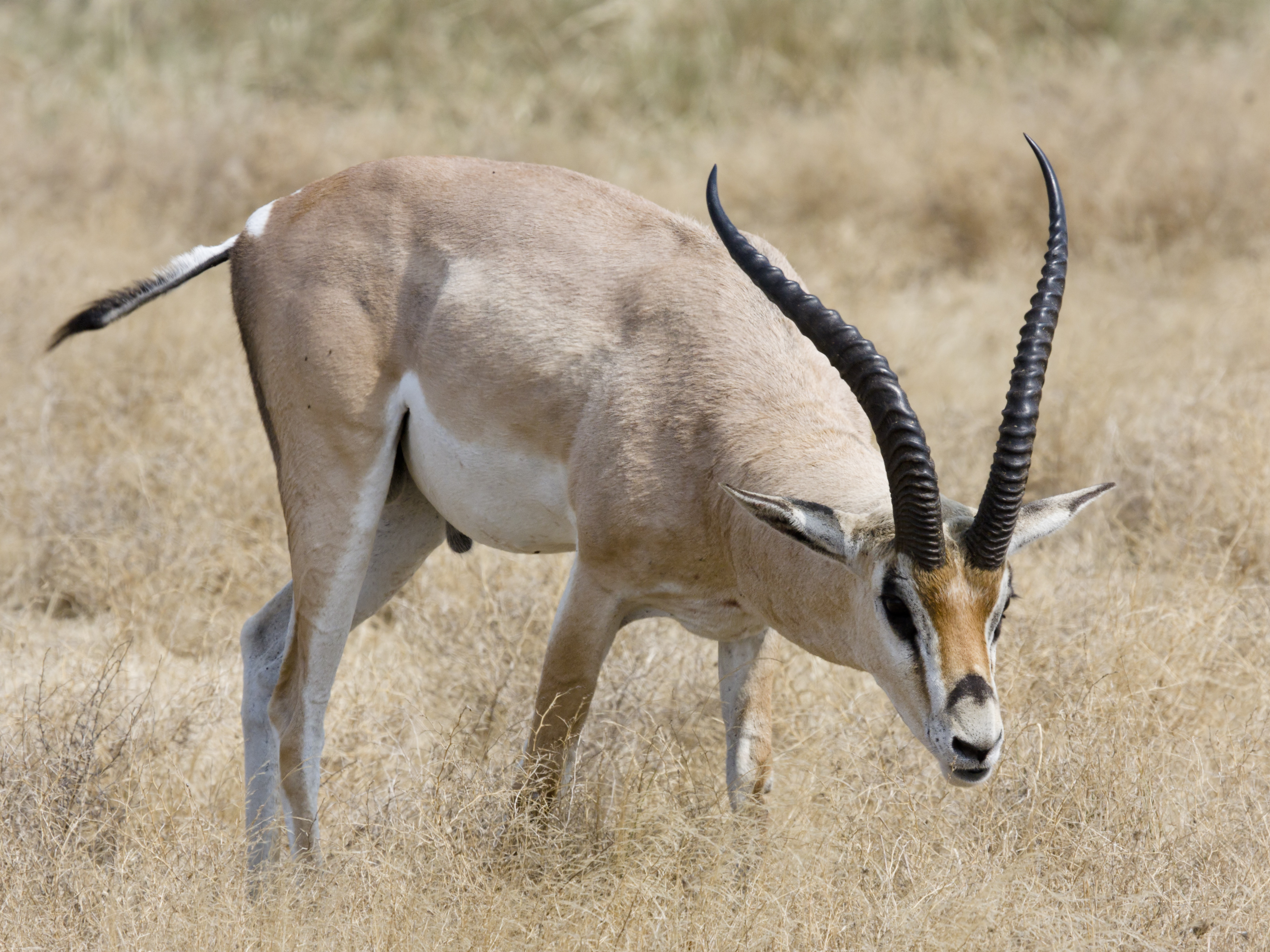
7. Lechwe
Lechwe stands 90 to 100 cm (35 to 39 in) on the shoulder and weighs from 70 to 120 kg (150 to 260 lb).
They’re golden brown with white bellies. Males are darker in color, however, the basic hue varies depending on subspecies.
The long, spiral-structured horns are vaguely lyre-shaped, they’re discovered solely in males. Lechwe is present in marshy areas the place they eat aquatic vegetation. They use the knee-deep water as safety from predators.
Their legs are coated in a water-repellant substance which permits them to run fairly quickly in knee-deep water. Lechwe is diurnal.

8. Gerenuk
Gerenuk is the giraffe of the antelope world. Yow will discover them in Tanzania, Kenya, and Ethiopia, stretching their necks to feed on arid landscapes.
The long-necked antelope known as the gerenuk, often called the giraffe gazelle, is found in some regions of East Africa. Naturalist Victor Brooke published the first description of the gerenuk, the only species in the genus Litocranius, in 1879. It stands out for having a long, thin neck and limbs.
Compared to other antelope species, the gerenuk is more antisocial. These creatures often move about alone or in small groups.
Gerenuks typically consist of females and their young or sub-adult males and dwell in tiny groups of ten or fewer people. Aside from when they are mating, adult males live alone. They create boundaries and mark them with urine and gland secretions. They seem to exclusively protect their lands from young males.
Amazingly they don’t have to drink water in any respect – they take all of the fluids they want from the vegetation.

9. Topi
The topi is a subspecies of the common tsessebe. It’s an extremely social and quick sort of antelope discovered within the savannas, semi-deserts, and floodplains of sub-Saharan Africa.
The topi subspecies Damaliscus lunatus jimela is more often known as a topi. It is a savanna-dwelling antelope species that is extremely sociable and swift. They have a beautiful reddish-brown to purplish-red coat and are medium-sized antelopes. They have distinct black spots on their face, top forelegs, hips, and thighs. The topi’s yellowish-tan legs give them a unique appearance as if they were wearing stockings.
Topi, also known as tsessebe or sassaby, is one of Africa’s most prevalent and widely distributed antelopes (Damaliscus lunatus). It belongs to the same family as the blesbok, hartebeest, and wildebeest, the Alcelaphini tribe.
It favors open grasslands devoid of plants or trees. Today, there are primarily 5 Topi subspecies; the Tsessebe is divided into two subspecies. It is endangered due to cattle rivalry and meat hunting. An estimate of the total population puts it at around 300,000.

10. Hartebeest
The hartebeest, often known as kongoni, is an African antelope. Eight subspecies have been described, together with two typically thought-about to be impartial species.
A large antelope with fawn coloring is called a hartebeest. Long legs, an extended snout, and a sharply sloping back are their most distinguishing features. Also called the northern hartebeest or bubal hartebeest. once happened from Morocco to Egypt throughout northern Africa. By the 1920s, it was completely gone. The International Union for the Conservation of Nature and Natural Resources declared it extinct in 1994. (IUCN).
A big antelope, the hartebeest stands simply over 1 m on the shoulder and has a typical head-and-body size of 200 to 250 cm.
They no longer have a large geographic range and are now mostly found in sub-Saharan Africa. Savannas and other areas with medium-to-high grasses are where you’ll mostly find these antelopes. Compared to other alcelaphines, they are more tolerant to thick grass and woodlands (archetypical plains antelopes).

11. Bontebok
The bontebok is a subspecies of Damaliscus pygargus, an antelope present in South Africa, Lesotho, and Namibia.
The antelope known as the bontebok may be found in Namibia, Lesotho, and South Africa. The nominate subspecies of D. pygargus, which naturally occurs in the Western Cape’s Fynbos and Renosterveld regions, and the blesbok, which is found in the Highveld, are its two subspecies. The bontebok and the common tsessebe are related.
Although bontebok has gone extinct in their native environment, their population has grown to the point that they are now extremely common and actively farmed since they make for popular game for hunters and are simple to maintain.
D. pygargus has two subspecies; the bontebok, occurring naturally within the Fynbos and Renosterveld areas of the Western Cape, and the blesbok occurring within the Highveld.
When savanna roaming, bontebok have a lot to be concerned about. Lions, leopards, cheetahs, hyenas, caracals, and jackals are examples of predators.
The herd had increased to 61 animals by the time the park was moved in 1961 to better accommodate the bontebok. Their current population is said to be between 2,500 and 3,000 people, all of whom are decedents of the original herd of 17 animals.

12. Bongo
Vibrant orange in look with blazing white stripes, this critically endangered antelope is present in components of Central Kenya and the Congo Basin. Like bushbuck, they’re woodland dwellers.
However, very uniquely, the feminine bongo even has spectacular horns, somewhat more than simply the males.
The largest, most vibrant, and friendliest of the African woodland antelopes, the bongo (Tragelaphus eurycerus), is a member of the Tragelaphini group of spiral-horned antelopes (family Bovidae). After the closely related giant eland and ordinary eland, it is also the third heaviest antelope. The bongo (Tragelaphus eurycerus) is a herbivorous woodland ungulate that spends much of its time at night. The beautiful reddish-brown coat of bongos is one of its defining features.
They are unique to tropical Africa’s rainforests with thick undergrowth. The lowland rainforests of West Africa, the Congo Basin, the Central African Republic, and southern Sudan are where you may find them specifically. Less than 100 mountain bongos remain in the wild due to a mix of illness, poaching, loss of forest habitat from illegal logging and cultivation, and other factors, according to the International Union for Conservation of Nature (IUCN).

13. Roan
The roan antelope is a savanna antelope present in West and Central Africa. It’s the namesake of the Chevaline mission, whose identity was taken from the French Antilope Chevaline.
In western, central, and southern Africa, savanna antelopes such as the roan antelope may be found. Its name, roan, refers to its paler underbelly, white cheeks and eyebrows, and black faces, which are lighter in females. It has a light, short beard, upright manes, and pronounced red nostrils.
In savannah environments south of the Sahara Desert, there is a patchy distribution of the uncommon and endangered Roan Antelope. Due to prior hunting pressures, it no longer occurs anywhere except in regions with strict protection measures.
Roan antelope are one of many largest species of antelopes; solely elands, bongos, and enormous male better kudus can exceed them in weight. The roan antelope, one of the biggest African antelopes, has long, pointed ears that are tufted at the tips, a gray coat with black and white face patterns, and long horns that are sharply bent backward. Female: The female has horns that are smaller and less highly ridged than the male’s.
Small herds of roan antelope dwell together, and when challenged, they engage in violent combat. Young, sick, and old people will be taken by huge predators like lions, hyenas, and African hunting dogs whereas healthy adults are likely to remain relatively invulnerable to predation.
Savannas are home to roan antelopes, which are mostly found in West and Central Africa. They like grasslands that are open or moderately forested, with medium-to-tall grass and availability to water.

14. Dik-Dik
Africa’s smallest antelope is simple to overlook. Dik-dik is widespread throughout Southern and East Africa, however, they’re so small they’re often fully coated by grass. Even sure massive lizards prey on them.
Any of the four species of tiny antelope that belong to the genus Madoqua that are found in the bushlands of eastern and southern Africa are referred to as “dik-diks.” Dik-diks are 50–70 cm long, 30–40 cm tall at the shoulder, weigh 3–6 kg, and have a lifespan of up to 10 years.
Since they are timid creatures, dik-diks will seek safety at the first alarm. In search of plants, they will lie flat on the ground. Hyenas, leopards, cheetahs, caracals, various other cats, jackals, baboons, eagles, and pythons are just a few of their predators.
Dik-dik is lovely and monogamous – they type lifelong pairs and watch one another when grazing, so one is consuming and one is on guard.
Habitat: The majority of this species’ historical range is still occupied by it. Both East Africa (from southern Somalia to central Tanzania) and Southern Africa (from northern Namibia and sections of southwestern Angola) are home to Kirk’s dik-diks.
Dik-diks are cautious and secretive animals that spend much of their time hiding in the undergrowth. However, when frightened, they leap off in a series of zigzag motions while yelling “zik-zik” or “dik-dik,” giving rise to their common moniker (Nowak 1983). When navigating their domain, they follow set paths.
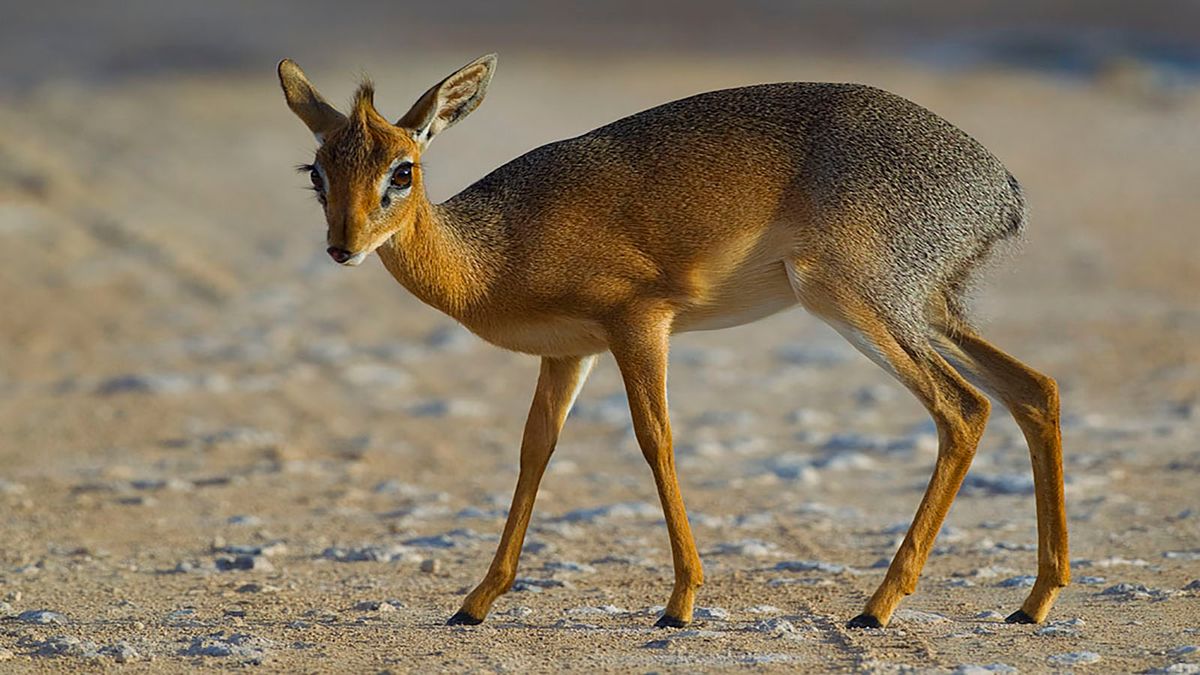
15. Beisa oryx
The ringed horns of a Beisa oryx can develop to nearly a meter in size. They rise straight and proud, with every ring a sign of the antelope’s age. An antelope species from East Africa is the East African oryx, sometimes referred to as the beisa.
It has two subspecies: the fringe-eared oryx, which is found south of the Tana River in southern Kenya and portions of Tanzania, and the common beisa oryx, which is found in steppe and semidesert across the Horn of Africa and north of the Tana River.
Oryx have tailored to abandon circumstances and might roam nice distances without water. Spot them in Botswana and Namibia, together with their relative, the gemsbok. The nominate subspecies of the East African oryx is the common beisa oryx, commonly known as the beisa oryx, and it is indigenous to Kenya and the Horn of Africa.
The beisa oryx used to live across a vast area of northeastern Africa, from Sudan through Ethiopia and down to Tanzania, but its range has drastically decreased. It is still widespread in northern Kenya and Ethiopia. In particular, grassland and bushes are home to Beisa oryx in dry and semiarid environments.

16. Waterbuck
The waterbuck is a big antelope discovered broadly in sub-Saharan Africa. It’s positioned within the genus Kobus of the household Bovidae. It was first described by Irish naturalist William Ogilby in 1833.
The common or ellipsiprymnus waterbuck and the defassa waterbuck are two of its 13 subspecies. 200 to 300 kg for men, 160 to 200 kg for women (Female). Status of conservation: Least Concern (Population decreasing). Size: 1.2 to 1.4 meters (At Shoulder). Herbivorous is the trophic level. 270-day gestation duration. 1.4 to 2.4 m in length.
The 13 subspecies are grouped into two varieties: the common or Ellipsiprymnus waterbuck and the Defassa waterbuck.
Waterbucks have long necks, small legs, and long bodies. They have manes on their necks and coarse hair (Estes, 1991). Their shoulder height ranges from 120 to 136 cm, while their head and body lengths range from 177 to 235 cm. Only male waterbucks have horns, which are forward-curving and can be 55 to 99 cm long.
Where are the waterbucks found? The waterbuck lives where there is water nearby in savanna grasslands, gallery forests, and riverine woods south of the Sahara, as its name would imply. These environments include tall grasses and wet areas where animals may hide from predators in addition to food.
Predators. The main predators are Hyenas, Lions, Leopards, however Crocodiles, Hunting Dogs, and Cheetahs all prey on Waterbuck.

17. Klipspringer
Skipping through the kopjes (rocky outcrops) of East and Southern Africa, klipspringer is the dancer of the antelope world.
The klipspringer is a little, hardy antelope that weighs between 8 and 18 kilos and measures 43 to 60 centimeters (17 to 23 12 inches) at the shoulder (18 to 40 pounds). Eastern and southern Africa are home to the little antelope known as the klipspringer. In 1783, German biologist Eberhard August Wilhelm von Zimmermann published his first description of the klipspringer, the lone member of its genus and subfamily/tribe.
Predators. Klipspringer is preyed upon by leopards, jackals, and spotted hyenas. Baboons and eagles can prey on calves. Klipspringers are extremely vigilant to predators and to warning signals of other species since they frequently have to leave their refuges to forage.
Agile and nimble they stay on harsh rock, which makes them a difficult catch for any predator.
Klipspringers have a diet that is similarly versatile; they consume a wide range of plants, including green grass, that are evergreen shrubs, succulents, vines, seeds, flowers, forbs, and flowers. Even while they are generally dormant throughout the day, they will leave their rocky havens to eat if necessary.
It has up to 15 years of life. The young are hidden in crevices for two to three months after birth. The klipspringer is most active in the morning and late afternoon, sleeping among rocks or behind overhangs during the warmest portion of the day.

18. Sable antelope
Shimmering fur and putting horns make sable one of all Africa’s most revered antelope species. They’re the type of species that safari connoisseurs will search for once they return for a 3rd or fourth time.
The sable antelope is an antelope that lives in the woodland savanna in East and Southern Africa, from the south of Kenya to South Africa. Angola also has a distinct population of sable antelope. Weight: 220 kg (Adult).
Status of conservation: Least Concern (Population stable). 273-day gestation period. 2 meters long (Adult). Sable antelope may go as fast as 57 km/h, despite their appearance as large and lumbering animals. For a distance of more than three kilometers, they can sustain their high speed.
Sable antelope are mostly diurnal (day activity), and they are less active in the summer. A single male, known as a bull, leads herds of 10 to 30 females and calves. Male sable antelopes will engage in combat with one another; they will kneel and use their horns.
Sables are the most elegant of the herbivore personalities, being calm and self-assured, if not a touch over-polished. They are universally admired by coworkers and acquaintances for their impressive physical presence and great work ethic.
You will discover the place where woodland meets savanna. And so they often stare straight again at you, somewhat than operating away.

19. Wildebeest
Extremely ample, wildebeest are essentially the most well-known African antelope. You can’t miss them within the Masai Mara or Serengeti, once they make their fabled annual migration.
Connochaetes antelopes, often known as wildebeest or gnus, are indigenous to Eastern and Southern Africa. They are a member of the Bovidae family of even-toed horned ungulates, which also contain real antelopes, cattle, goats, sheep, and other species.
The lion, hyena, African wild dog, cheetah, leopard, and crocodile are the main predators that hunt wildebeest, and they appear to prefer it over other prey.
Wildebeest are friendly, possessive creatures. Small herds of females and their young form, with many of the territories crossing across. Males will leave their herd and join a bachelor herd after roughly a year. Males start to become extremely territorial at 4 or 5 years old and leave the bachelor herd.
20. Gemsbok
The gemsbok, gemsbuck, or South African oryx is a big antelope within the genus Oryx. It’s native to the arid areas of Southern Africa, such as the Kalahari Desert. Some authorities previously included the East African oryx as a subspecies.
A huge antelope belonging to the genus Oryx is called a gemsbok or South African oryx. It is indigenous to Southern Africa’s extremely dry, desert areas, particularly the Kalahari Desert. The East African oryx, also known as the beisa oryx, was once classed as a subspecies by certain authorities.
After four months, calves are able to feed themselves, continuing with the parent herd but no longer nursing from their mothers. In one and a half to two years, gemsboks mature. A lifetime of 20 years is usual.
Every nine months, gemsbok breed on average, and there is typically little time between giving birth and being pregnant again. As long as there is water available, the breeding season lasts all year.
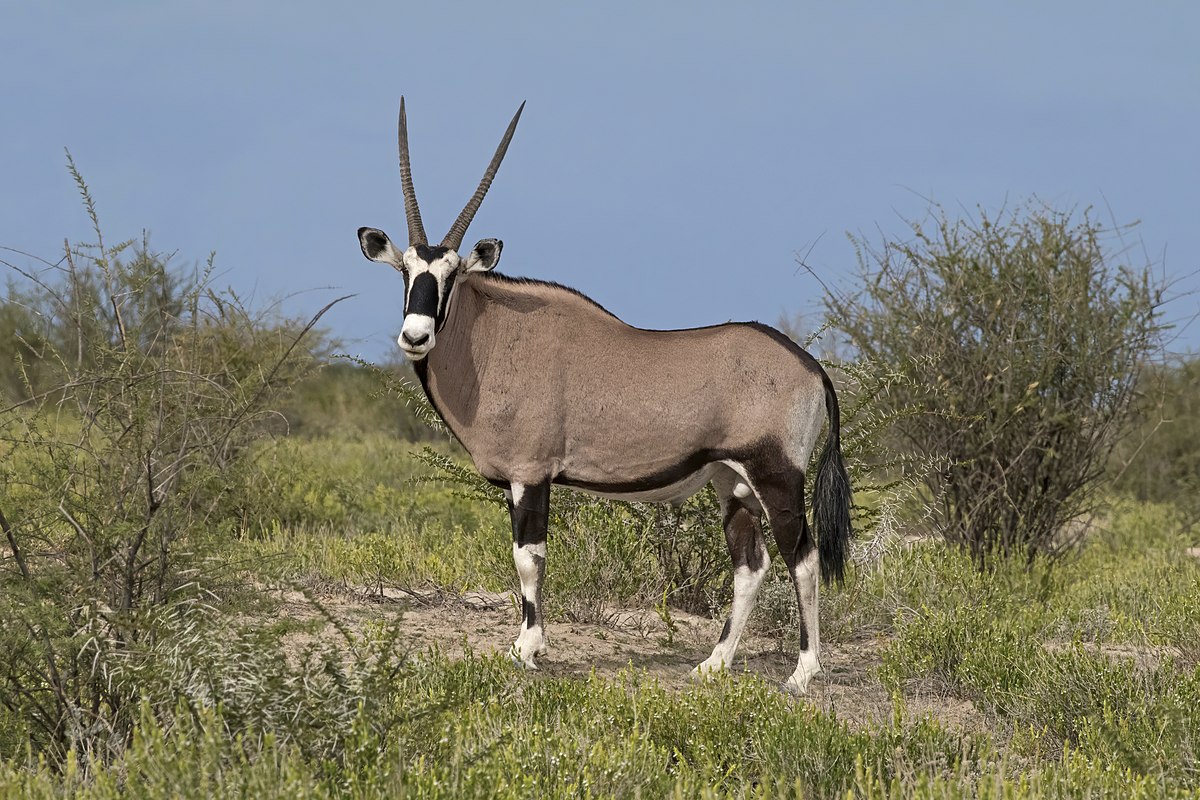
21. Impala
Aepyceros melampus, sometimes known as the impala or rooibok, is a medium-sized antelope that may be found in eastern and southern Africa. The impala is a medium-sized antelope present in jap and southern Africa. The only member of the genus Aepyceros, it was first described to European audiences by German zoologist Hinrich Lichtenstein in 1812.
The majority of an impala’s time is spent moving, resting, eating, and grooming during the day. They spend most of the night lying down or thinking. The only ungulates known to engage in allogrooming, or reciprocal grooming, are impalas.
Two subspecies are recognized—the common impala, and the bigger and darker black-faced impala.
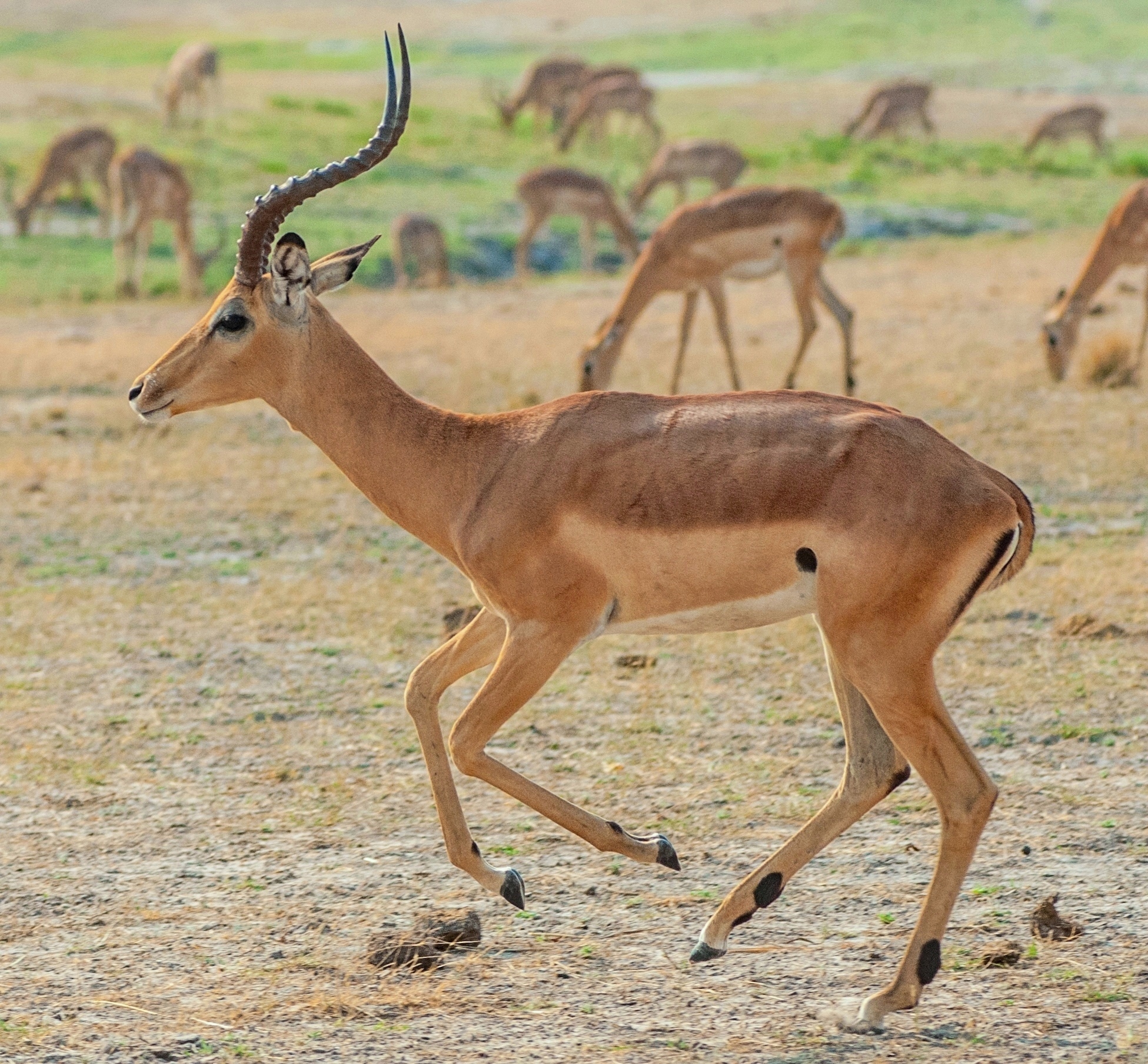
Be kind to all animals on the planet. I hope this article on African horned deer species was interesting to read.
Other Recommended Reading
- Kafunta Safaris – Review | Features | Costs | Distance
- Moremi Game Reserve Safari Guide and Stay
- Tau Pan Camp – Price, Lodge, and Safari Plan
- Kwando Safaris Botswana – Complete Travel Guide
- Kwando Lebala Camp – Adventurous Safari Guide
- Okavango Delta Safari Guide for Single or Family
- Lake Nyasa – Facts | Location | Travel Guide
- Zambezi Expeditions – A Guide Based on Reviews
- Khwai Tented Camp Overview – Botswana Botswana
- Linyanti Bush Camp Overview – Botswana Safari
- Khwai Bush Camp Overview – Botswana Safari
- Hyena Pan Tented Camp Overview – Botswana Safari
- Machaba Camp Stay and Features – Botswana Safari
- Belmond Khwai River Lodge – Botswana Safari
- Selinda Explorers Camp Review – Botswana Safari
- Entabeni Nature Conservancy Travel Guide | Stay
- 4 Stunning Eco-Resorts in Tanzania for Travelers
- South Luangwa Safari- Tips on Travel Plan | Lodges
- 13 Madagascar Safari Locations – Cheap Budget Trip
- Safari Island Maldives – Travel Plan | Review | Stay

